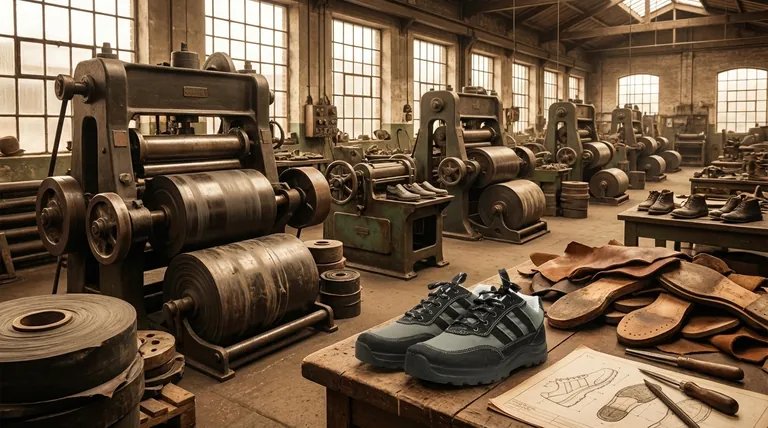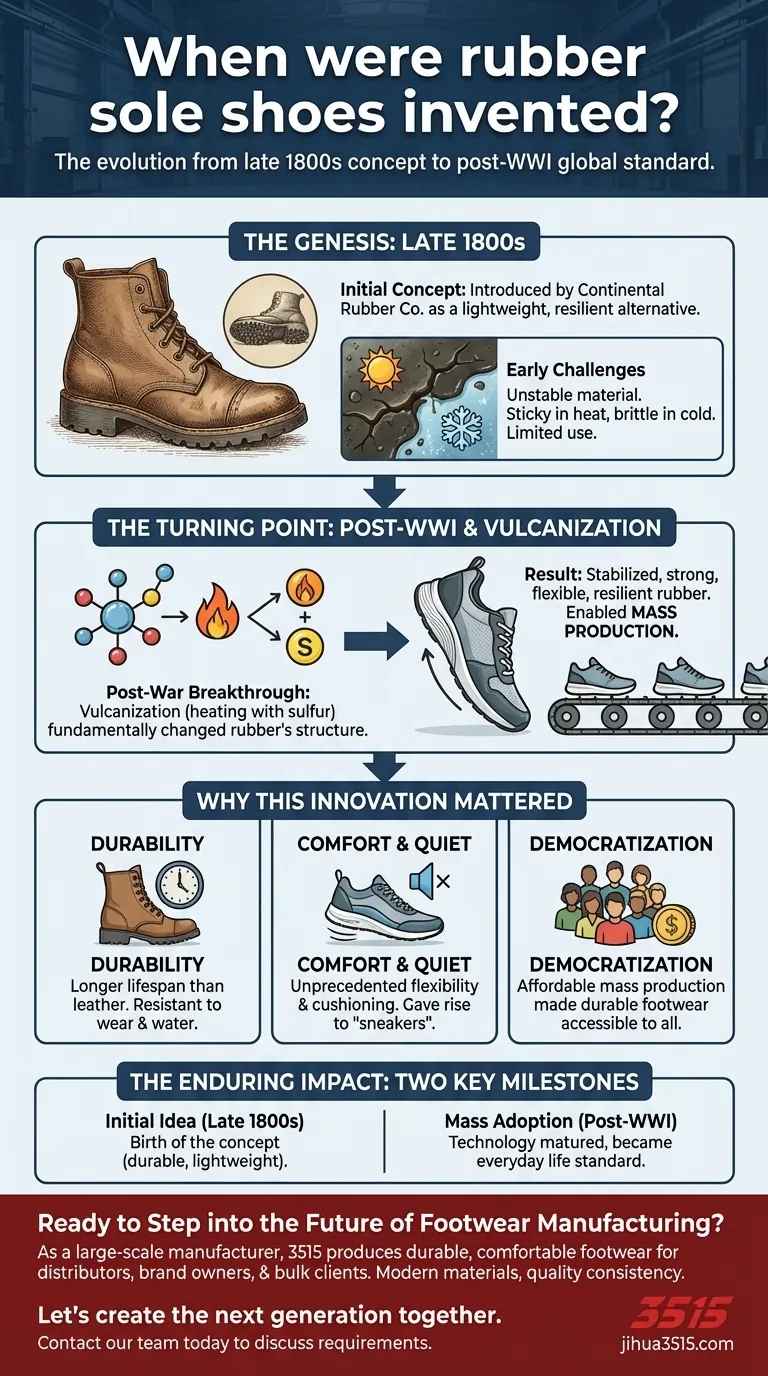The first rubber-soled shoes were invented in the late 1800s. They were introduced by the Continental Rubber Company as a novel, lightweight, and durable alternative to traditional leather or wood soles. However, their widespread adoption and the form we recognize today are tied to a critical technological advancement that came later.
While the concept originated in the late 19th century, it was the perfection of vulcanized rubber technology after World War I that transformed rubber-soled shoes from a niche product into a global standard.

The Genesis of the Rubber Sole
The journey of the rubber sole began with a simple goal: to create better footwear. Traditional materials had significant limitations that inventors sought to overcome.
The Initial Concept
In the late 1800s, the Continental Rubber Company pioneered the first shoes featuring rubber soles. The primary driver was the need for a material that was more resilient and lighter than the heavy, rigid soles common at the time.
Early Challenges
Early forms of rubber were not ideal. They were often unstable, becoming sticky in the heat and brittle in the cold. This limited the practicality and mass appeal of the initial designs, confining them to specialized uses.
The Turning Point: Vulcanization and Mass Adoption
The true revolution in footwear didn't come from the sole itself, but from the process used to treat the rubber. This chemical innovation unlocked the material's full potential.
A Post-War Breakthrough
Following World War I, vulcanized rubber technology became widespread. This process involves heating rubber with sulfur, which fundamentally changes its molecular structure.
The Impact of Vulcanization
Vulcanization stabilized the rubber, making it consistently strong, flexible, and resilient across a wide range of temperatures. It was no longer a temperamental material but a reliable, high-performance one.
From Niche to Ubiquitous
This new, improved rubber was perfect for mass production. It allowed manufacturers to create affordable, comfortable, and long-lasting shoes for the general public, leading to the explosion in popularity of "sneakers" and other casual footwear.
Why This Innovation Mattered
The shift to rubber soles was not just a change in material; it was a fundamental change in the function and accessibility of footwear for millions of people.
A New Standard of Durability
Vulcanized rubber soles offered significantly longer lifespans than traditional leather, which would wear down, absorb water, and require frequent repair or replacement.
Unprecedented Comfort and Quiet
Rubber provided a level of flexibility and cushioning that was impossible with rigid leather or wood. This new comfort changed how people moved and also made footwear significantly quieter, giving rise to the term "sneakers."
Democratizing Footwear
The ability to mass-produce vulcanized rubber soles made durable footwear more affordable and accessible than ever before. This put comfortable, practical shoes within reach of the average person.
The Enduring Impact on Modern Footwear
Understanding the history of the rubber sole requires looking at two key milestones: the initial idea and the technology that perfected it.
- If your primary focus is the origin of the idea: The late 1800s marks the birth of the concept of using rubber as a durable, lightweight sole.
- If your primary focus is the start of mass adoption: The post-World War I era is when the technology matured, making rubber-soled shoes a part of everyday life.
This two-part evolution fundamentally redefined what a shoe could be, setting the stage for all modern athletic and casual footwear.
Summary Table:
| Key Milestone | Time Period | Significance |
|---|---|---|
| Initial Invention | Late 1800s | The Continental Rubber Company created the first rubber soles as a lightweight alternative to leather/wood. |
| Key Challenge | Late 1800s - Early 1900s | Early rubber was unstable, limiting practicality and mass appeal. |
| Critical Breakthrough | Post-World War I | Widespread adoption of vulcanization made rubber durable, flexible, and suitable for mass production. |
| Result | 1920s Onward | Rubber-soled shoes became affordable, comfortable, and ubiquitous, revolutionizing casual and athletic footwear. |
Ready to Step into the Future of Footwear Manufacturing?
As a large-scale manufacturer, 3515 produces a comprehensive range of durable, comfortable footwear for distributors, brand owners, and bulk clients. Our production capabilities encompass all types of shoes and boots, leveraging modern materials and processes to deliver the quality and consistency your business needs.
Let's create the next generation of footwear together. Contact our team today to discuss your manufacturing requirements.
Visual Guide

Related Products
- Durable Rubber-Soled Utility Shoes for Wholesale & Custom Brand Manufacturing
- Durable Canvas Work Shoes with Rubber Lug Sole | Wholesale Manufacturer
- Wholesale Breathable Training Shoes Custom Athletic Footwear Manufacturer
- Wholesale Durable Camouflage Canvas Shoes with High-Traction Cleated Rubber Sole
- Premium KPU Athletic Safety Shoes for Wholesale
People Also Ask
- What are the benefits of rubber work shoes? Unbeatable Protection for Wet & Demanding Jobs
- What historical breakthrough in 1844 contributed to modern shoe sole manufacturing? The Vulcanization Revolution
- What makes rubber sole shoes an economical and practical choice? Unmatched Durability & All-Weather Value
- What are rubber soled shoes? The Ultimate Guide to Durable, All-Weather Footwear
- Which type of sole is better for premium sneakers and why? The Definitive Guide to Rubber Outsoles



















